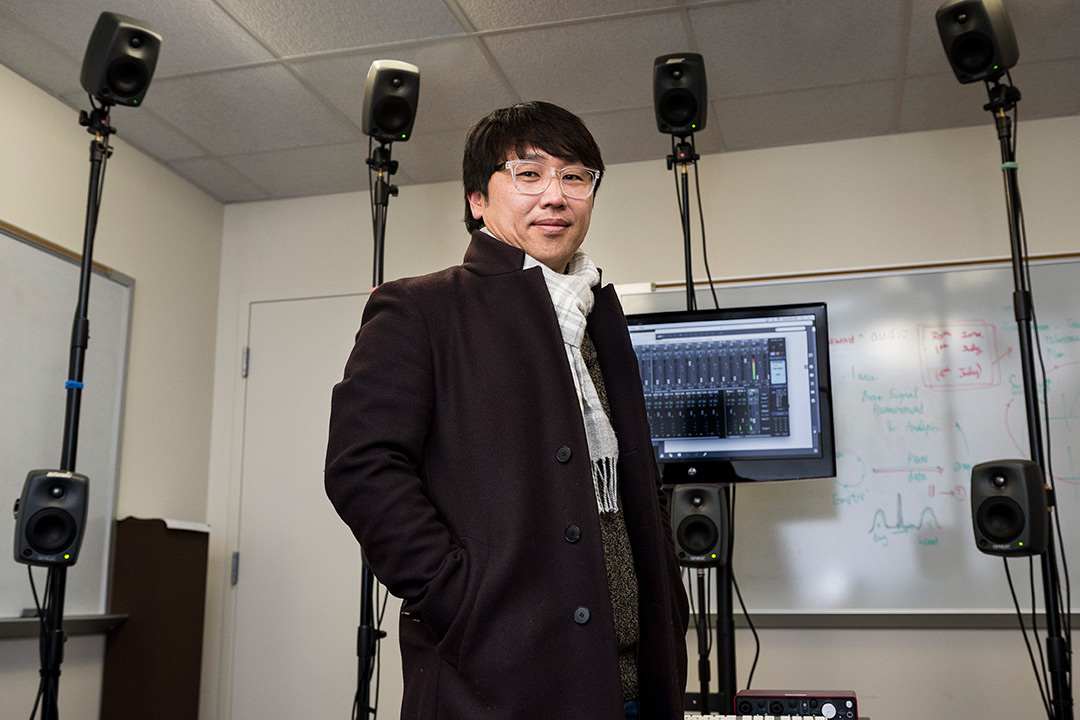Team receives grant to recreate the ‘sound signature’ of cultural heritage sites
Sungyoung Kim will lead ‘The Soundscape Project’ to preserve aural heritage
Elizabeth Lamark
Sungyoung Kim, an associate professor of audio engineering technology at RIT, is leading a team of researchers to develop a set of tools using advanced augmented and virtual reality technology to preserve and replicate the acoustics of historical venues.
Advanced audio technologies being developed are helping to preserve the unique sounds of historic sites from recording studios in Nashville, Tenn., to a pre-Columbian archeological site in Peru.
Sungyoung Kim, an associate professor of audio engineering technology at Rochester Institute of Technology, is leading a team of researchers to develop a set of tools using advanced augmented and virtual reality technology to preserve and replicate the acoustics of historical venues. The project would bring attention to the overlooked work in preserving aural heritage.
 A. Sue Weisler Sungyoung Kim, far right, has been researching new audio engineering technology trends and will lead work this spring to preserve the unique acoustics of several national and international landmarks. He is seen here with students Jacob Cozzarin and Kyunghwan Sul, and a previous guest to his studio, Shu Kitajima from the Japanese Broadcasting System.
A. Sue Weisler Sungyoung Kim, far right, has been researching new audio engineering technology trends and will lead work this spring to preserve the unique acoustics of several national and international landmarks. He is seen here with students Jacob Cozzarin and Kyunghwan Sul, and a previous guest to his studio, Shu Kitajima from the Japanese Broadcasting System.“We proposed a comprehensive method to preserve and reconstruct a ‘sound’ or ‘auditory’ heritage at risk of being lost. To date, there are many projects to visualize what humans have constructed; yet, less importance was given to their soundscapes,” said Kim, who is part of the Department of Electrical, Computer and Telecommunications Engineering Technology in RIT's College of Engineering Technology. “The project focuses on auralization rather than visualization of soundscapes so that people can aurally experience the target space even if that space is one day demolished.”
Auralization is a process to simulate a unique acoustical environment, or a sound field, in a virtual or physical space. Currently, preservation of images and visual information is a research trend, yet without appropriate auditory information, visual representation of cultural heritage in any format could mislead users. Auralization is equally important to visualization for the seamless re-creation of it, Kim explained.
The research project focuses on several areas or specific buildings designated as landmarks and will be developed as case studies:
- American recording studios in Nashville’s Historic Music Row, designated in 2015 by the National trust for Historic Preservation, as an example of a small room venue
- The former Rochester Savings Bank, located in Rochester, N.Y., and listed on the National Register of Historic Places with historical significance for art, architecture and commerce, as an example of large and public space acoustics
- The 3,000-year-old UNESCO World Heritage Site at Chavín de Huántar, Peru, one of the best-preserved examples of pre-Columbian architecture in the Americas, an intersection of archaeology, ancient American prehistory and interior architecture
“These culturally distinct and diverse spaces provide distinct types of aural environments that demonstrate the extensibility of our method,” Kim said. “The goal of this NEH program, and our research and development, is to build a standard methodology of culture preservation and digital access for non-expert humanities researchers. Through these case studies, we want to form a scalable method to capture and reproduce any important aural heritage.”
The team received a three-year grant from the National Endowment for the Humanities (NEH) for $347,702 for “A scalable method for digital preservation and access to aural heritage” to focus on spaces considered culturally, architecturally and temporally distinct examples of rare aural heritage. Researchers on the team include Doyuen Ko, associate professor of audio engineering at Belmont University in Nashville, and Miriam Kolar of Amherst College, where she is the Five College Mellon Postdoctoral Fellow in Digital Humanities.
Kim worked on similar projects over the past 10 years, several while he was a research associate with Yamaha Corp. in Japan. The current project, while similar, is more comprehensive, focusing on preservation and some aspects of live performance. The captured aural information will be reproduced through a scalable method developed by the researchers that would allow users in the different types of venues to choose reproduced formats. For example, a common reproduction format can be heard through headphones or speakers in a home theater system.
“More and more, I have found that concert halls and auditoriums need this technology to provide performers with various acoustic settings for specific purposes,” Kim said, adding an example of an auditorium that can provide both short reverberation time—the build-up and fading of sound in a space—for small ensembles, and a more complex auditory format for choir and some baroque ensembles which require longer reverberation time. “The technology can potentially ‘transform’ an auditorium into a preserved church or concert hall venue virtually and instantly. Since, it can be applied for existing spaces, many choose to renovate their acoustics using this technology so that those spaces can be multi-purposed and multi-functional.”













